Focus Question: What was the impact of the important domestic events that took place during the war?
WPA US World War II Homefront Poster, 1942
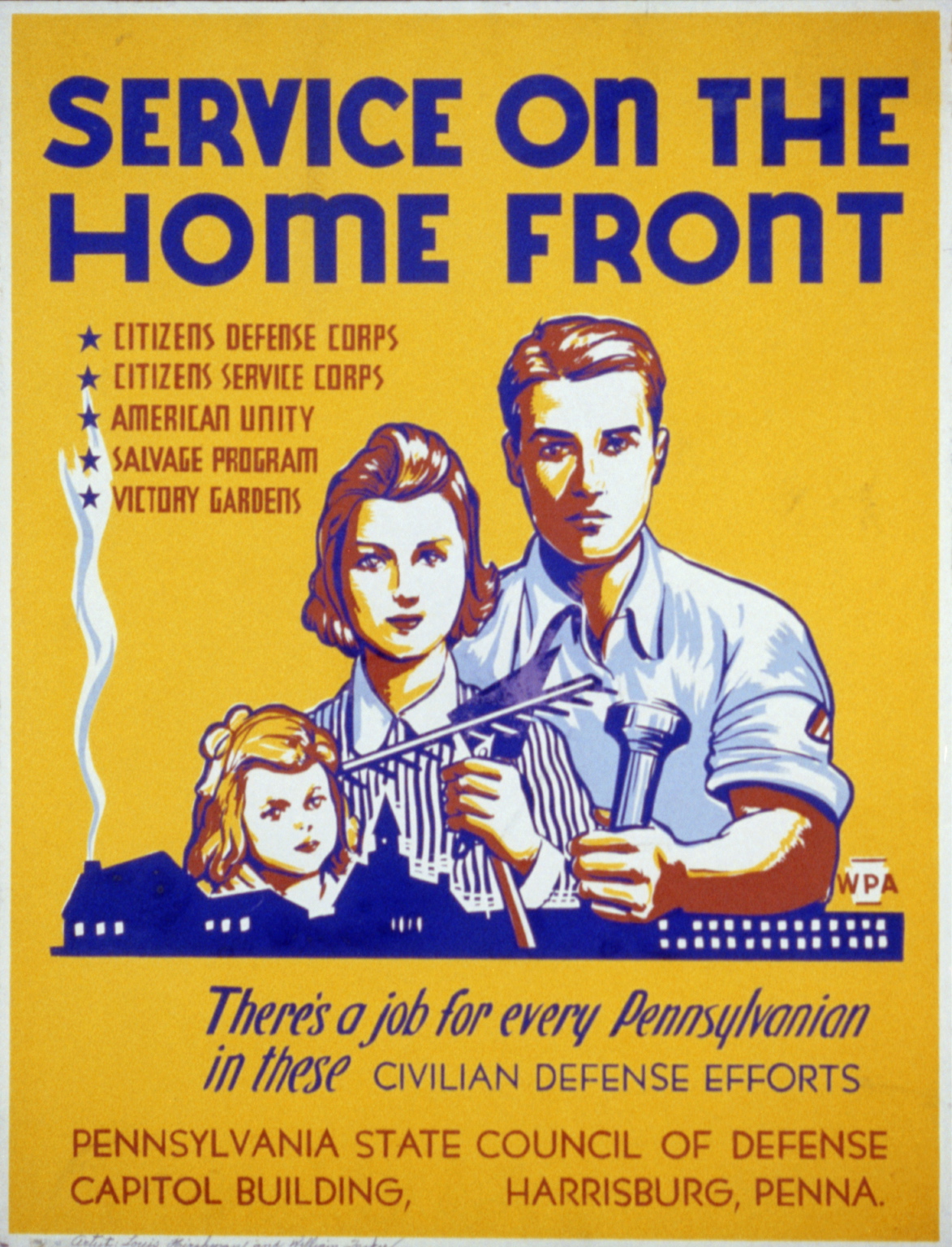
Topics on the Page
Overview of the Homefront during World War II
War inspired economic growth helping to end the Great Depression
A. Philip Randolph and the efforts to eliminate employment discrimination
- The Brotherhood of Sleeping Car Porters
The entry of large numbers of women into the workforce
 World War II Propaganda Posters
World War II Propaganda Posters
 Link to AP United States History Key Concept 7.2: Traditionalism, Modernity and Mass Culture
Link to AP United States History Key Concept 7.2: Traditionalism, Modernity and Mass Culture
Cross-Link: The internment of West Coast Japanese-Americans in the U.S. and Canada
Overview
While Europe and the Pacific were ravaged by combat, important events were taking place on American soil.
- The bombing of Pearl Harbor and subsequent entry of the U.S. into war reinvigorated the country's economy and brought it out of depression. New industries funded by massive military contracts were born, providing millions of jobs at higher wages.
- While men fought overseas, women stepped into new roles and began to work outside the home, often in traditionally male-dominated industries.
- Through the efforts of A. Phillip Randolph, working class black Americans also benefited from new employment opportunities. Randolph organized African-Americans, created a union among sleeping car porters, and successfully pressured lawmakers to end discrimination in the national defense industry.
- One group of Americans who did not find favor during the war were Japanese-Americans. Fueled by public fear of espionage and xenophobia, FDR issued an order to collect and preemptively relocate Japanese-Americans into camps throughout the country. For four years, 120,000 Japanese-Americans were forced to leave in bleak conditions, in blatant disregard of Constitutional rights.
Rural schoolchildren in front of World War II Homefront Posters, 1943
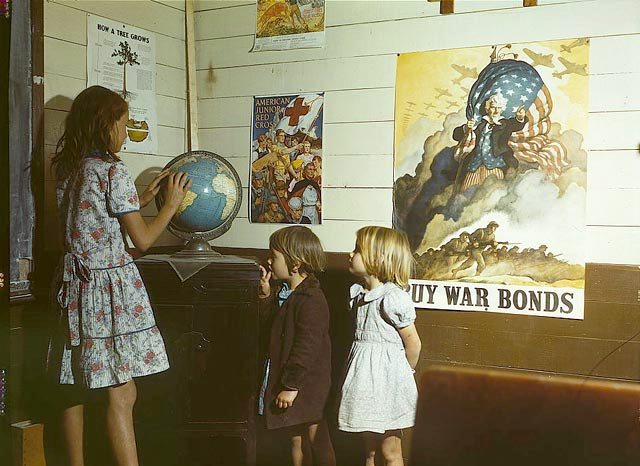

Student Voices from World War II and the McCarthy Era.
For primary sources on the Homefront in Massachusetts https://www.archives.gov/boston/exhibits/homefront

Timeline of Important Events on the Home Front
Crash Course: The Home Front and meaning of the war
A. War Inspired Economic Growth and the End of the Great Depression
Background:
The 1930s brought about economic depression in the United States. The stock market crash of 1929 and the economic depression brought extensive unemployment, reaching up to 25 percent by early 1933.
Most other workers, at the very least, experienced pay cuts. President Herbert Hoover, who served during the early years of the Depression (1929–33), took a hands-off approach. As economic conditions worsened, Americans no longer supported Hoover.
Franklin Roosevelt was elected President in 1932 and when he took office in early 1933 he brought in a massive program called the New Deal, which consisted of social and economic recovery programs.
Each of President Roosevelt's programs had its individual success. These programs regulated wages, prices, which helped families get a steady income and buy things they needed. Other programs employed people as conservation workers, artists, writers, and laborers. Social Security was introduced to help some of the elderly who could no longer work and whose savings were gone.
Although these programs assisted individuals greatly, it did not eliminate the problem of the economic downturn the Great Depression had created.
Click for a "Crash Course" in the New Deal
New Deal Lesson Plan
- Debate: Was the New Deal a success or not?
- Involves group work as well as a whole class discussion
- Includes primary sources to analyze before the activity
For a look at more primary documents from the Depression, see Archives in the Attic: Documents of the Great Depression.

Freedom from Fear is a 1943 painting by Norman Rockwell as part of his "Four Freedoms" series. The Four Freedoms (Freedom of Speech, Freedom of Worship, Freedom from Want, Freedom from Fear) were coined by FDR, and were even incorporated into the Atlantic Charter!
In September 1939, another world war erupted in Europe. This new global war would pit the Allies (United States, Britain, China, and the Soviet Union) against the Axis powers (Germany, Japan, and Italy).
After the surprise Japanese attack on Pearl Harbor on December 7, 1941, the United States entered World War II. The U.S. entry into the war started a full industrial mobilization effort in 1942.
Industrial mobilization involves the manufacture of massive amounts of war goods, including ships, tanks, arms, ammunition, and warplanes.
Roosevelt, who had strong differences with business interests, had to seek cooperation from businesses for the war mobilization effort.
As a result, many policies and programs introduced by Roosevelt to combat the effects of the Great Depression, including regulation of industry, would come to an end.
Funded by massive military contracts, industry provided millions of new jobs and wages were higher than the pay offered during the hard times of the Great Depression. The increase in jobs and pay finally brought the Great Depression to a close. With increased military spending for the production of war materials and other goods, enthusiasm over the economy returned to the general populace.[1]
This New York Times article compares America's economy at the time of WWII to America's economy today. An interesting read, it analyzes the validity of the theory of military spending ending economic downturns. Read it here
World War II Rationing on the U. S. Homefront
 |
| This graph shows unemployment in the US. The unemployment level drops significantly with WWII |
B. A. Philip Randolph and the efforts to eliminate employment discrimination
A. Philip Randolph
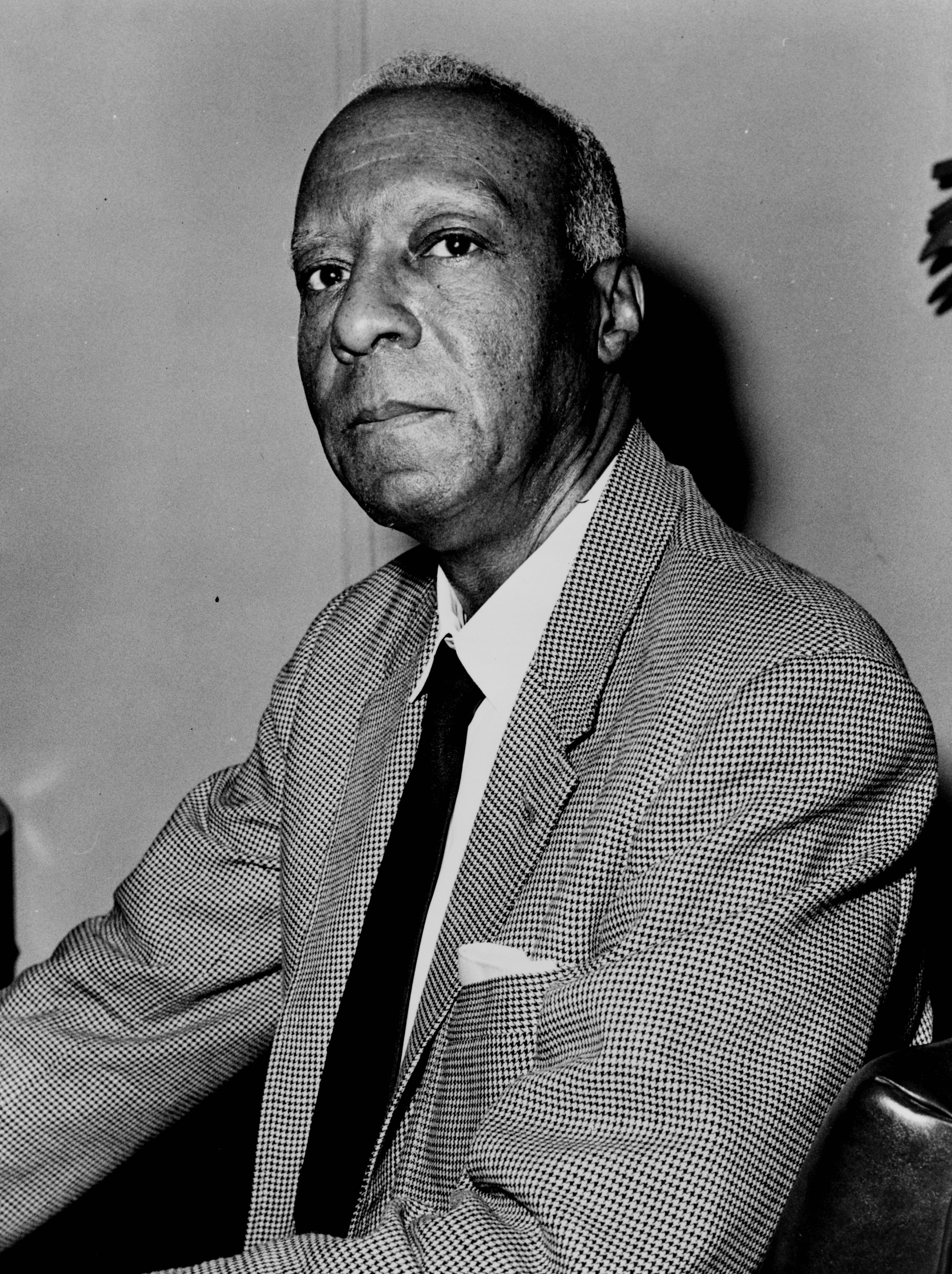
"Will V-Day Be Me-Day Too?" by Langston Hughes is a powerful statement by the African American author and poet.
.png) Click here for a learning plan comparing Randolph to Marcus Garvey, Booker T. Washington, and W.E.B. DuBois.
Click here for a learning plan comparing Randolph to Marcus Garvey, Booker T. Washington, and W.E.B. DuBois.
 Click here to read stories and view pictures depicting the African American World War II experience
Click here to read stories and view pictures depicting the African American World War II experience
- Many African Americans felt as though the Civil Rights Movement lost significant progress since the entire country's attention shifted to war mobilization
 Video on Racial Tensions during WWII https://www.youtube.com/watch?v=8LqNMA3Vpdo
Video on Racial Tensions during WWII https://www.youtube.com/watch?v=8LqNMA3Vpdo
About minorities on the homefront https://www.pbs.org/thewar/at_home_civil_rights_minorities.htm
More about the Double Victory Campaign https://www.nationalww2museum.org/war/articles/double-v-victory
C. Women in the Workforce
A real-life "Rosie the Riveter" operating a hand drill at Vultee-Nashville, Tennessee,
working on an A-31 Vengeance dive bomber (1943)
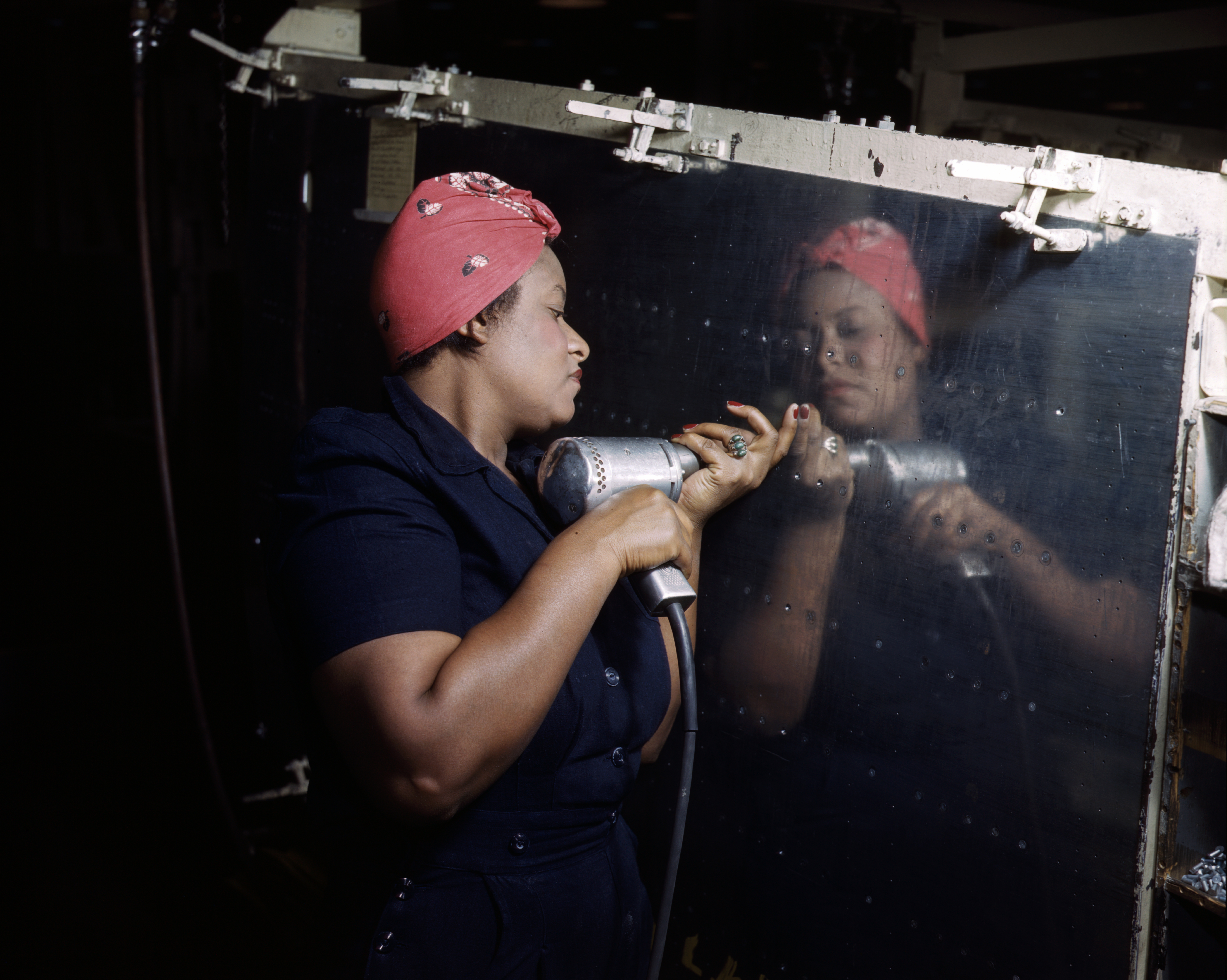
When the United States entered WWII after the bombing of Pearl Harbor, the country's social, economic and industrial landscape changed. Very quickly, auto factories were converted into aircraft plants and new factories were built.
- As the men were drafted into combat, women began to enter into regions of the work force that were traditionally restricted to men. Soon, housewives and young daughters answered the national call to drop their aprons and pick up their toolboxes to support their country.
- The "Rosie the Riveter" icon served a very important role in mobilizing women into the work force during this time. Women before the war were seen as homeworkers and housewives. The ideal American woman in the prewar years was not at all prepared to participate in the war effort or serve as an icon for women entering male-dominated jobs.
- The prewar image would have to change to successfully recruit women into the workforce. Rationally, it would be safe to say that "Rosie the Riveter" was born out of necessity, even if it was propaganda. Themes of patriotism and glamor were used to appeal to these women who were to take the place of their men who were defending democracy. Taking a war job was not seen as a choice; it was simply a patriotic duty.[3]
Women who went to work in the factories during the war were referred to as "Rosies".
- Click here for an Ellen Degeneres interview with a 93 year-old woman who has worked in a munitions factory since WWII and talks about her experiences entering a "man's job"
Read about how women of different races were affected in different ways in the workplace during WWII, here
 Click here to listen to the song "Rosie the Riveter" by The Four Vagabonds.
Click here to listen to the song "Rosie the Riveter" by The Four Vagabonds.
For more,
 Rosie The Riveter: Real Women Workers from World War II from the Library of Congress
Rosie The Riveter: Real Women Workers from World War II from the Library of Congress
- Women in World War II from the Springfield Armory provides resources about women's experiences in our region of the country.
Hedy Lamarr from the film Come Live with Me, 1941

See Historical Biography page on Hedy Lamarr, Actress and Inventor
- An interesting addition to the list is the Hollywood actress, Hedy Lamarr, who is also recognized as a female Inventor for her work on a torpedo guidance system that was used successfully by the American military.
 |
| Women in an aluminum factory making ammunition, 1942 |

- Click here for information on how Rosie the Riveter influenced pop culture, including a section on Marilyn Monroe and her contribution to the war effort.
 1943 Video "Women of Steel"
1943 Video "Women of Steel"
A Rosie is a Rosie is a Rosie
- Read about both popular and unpopular portrayals and propaganda posters of Rosie the Riveter from all around the world!
World War II Propaganda Posters
US Government propaganda poster, 1942
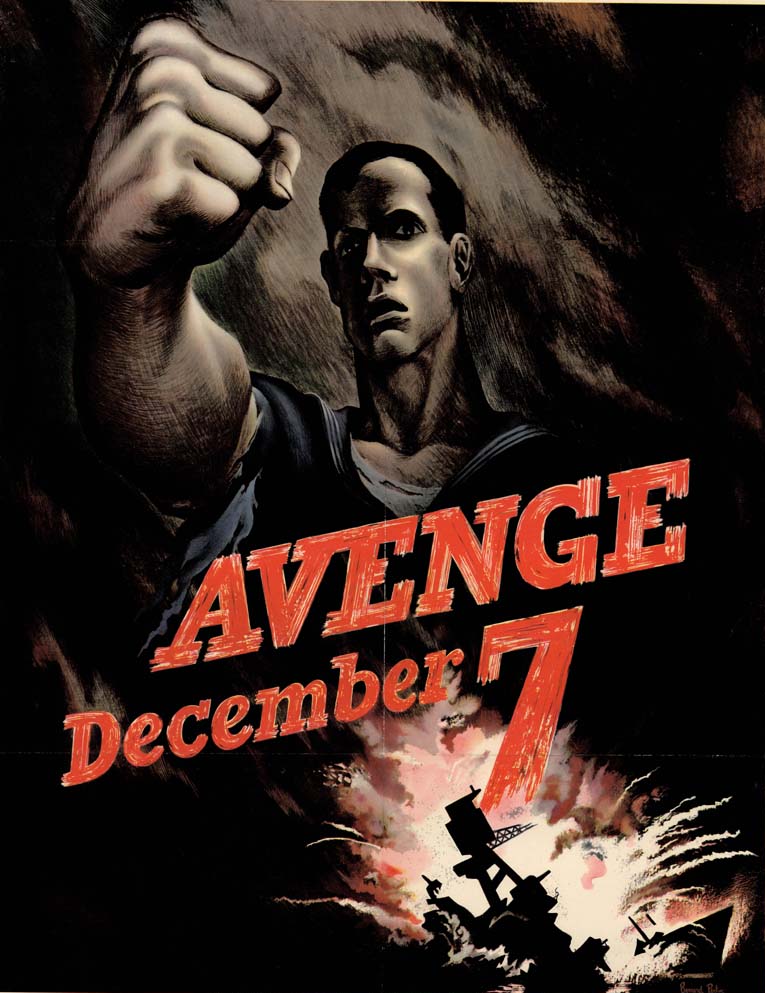
At the start of WWII, Americans did not want to become involved. However, the government felt that the US would become involved eventually and started creating pro-war propaganda so people would support involvement.
- Propaganda included radio announcements, but the most popular form was posters.
- Before Pearl Harbor, it did not have a great impact. Once Pearl Harbor was bombed, the pro-war propaganda increased even more.
- Americans responded more to this propaganda because the war seemed closer to home.
- The posters aimed to increase enlistment, women in the workplace, rationing, and other important topics relating to the war.
- Many of these propaganda materials used overtly racist appeals to rally support for the war effort.
.png)
Wikimedia Commons has a excellent collection of propaganda posters under the heading World War II Home Front in the United States.
Click here for the National Archives page "Powers of Persuasion"
Click here for a collection of 300 World War II-era propaganda posters issued by the US government
.png)
- Click here for a lesson plan from History Detectives on WWII propaganda
- Click here for a lesson plan on analyzing propaganda
Kid's Corner Interactive Website
- Make your own propaganda poster, do a puzzle, complete a word search, and more!
Anti-Japanese propanganda cartoon from 1943 https://www.youtube.com/watch?v=sy9rGAO-qfc

The Election of 1944
Map Key: Red States were won by Republican Thomas Dewey; Gray States by President Franklin Roosevelt
This was FDR's fourth election for President. The Republican candidate was Thomas Dewey.
- The two men held similar positions on most topics, especially ones relating to the war.
- Dewey mainly ran on the idea that the current administration was made up of old men and that there needed to be a change.
- FDR won the election with 432 electoral votes, Dewey received 99 electoral votes.
- Although he easily won the election, this was the lowest amount of electoral votes FDR received in any of his elections.
- Click here or here to read more about the election of 1944.
Click here for a comparison of the 1940 and 1944 elections from the New York Times
Click here to see a video made by the U.S. Office of War Information video portraying America as a country able to hold a peaceful election during a time of war.
.png)
Click here for FDR's 1945 inaugural speech
Click here for Dewey's statement from election night, Nov. 6, 1944
.png) The Flags of our Fathers - https://www.amazon.com/Flags-Our-Fathers-James-Bradley-ebook/dp/B000JMKN7E
The Flags of our Fathers - https://www.amazon.com/Flags-Our-Fathers-James-Bradley-ebook/dp/B000JMKN7E
This is a link to the book, The Flags of our Fathers by James Bradley and Ron Powers. This book features many interviews and photographs from the surviving members of the Flag Raising at Iwo Jima. The main focus of the book follows the survivors of the flag raising and how they were sucked into pushing propaganda for the US military.
Works Cited:
[1] Lewis, C (2002). The United States in the Great Depression. Retrieved April 26, 2007, Web site: http://www.colorado.edu/AmStudies/lewis/2010/newdeal.htm
[2] (2007). Asa Philip Randolph. Retrieved April 26, 2007, from America's Union Movement Web site: http://www.aflcio.org/aboutus/history/history/randolph.cfm
[3] Sorenson, A The Image and Reality of Women who Worked During WWII. Retrieved April 26, 2007, from Rosie the Riveter: Women Working During World War II Web site: http://www.nps.gov/pwro/collection/website/rosie.htm
[4] (2007). Retrieved April 26, 2007, from Japanese Internment and POWs Web site: http://www.teacheroz.com/Japanese_Internment.htm
[5} http://www.museum.siu.edu/museum_classroom_grant/Museum_Explorers/school_pages/bourbonnais/page6.htm [6] http://www.pbs.org/childofcamp/
Comments (0)
You don't have permission to comment on this page.